Zanzibar is famous for its abundance of reef fish and variety of small marine life. Sea creatures such as nudibranch, leaf fish, frog fish, crocodile fish, seahorse, mantis shrimp, octopus, are very common to spot. It is this that makes Zanzibar a great place for macrophotography.
Dolphins are common in Mnemba Atoll and even turtles can be found on several of Zanzibar dive sites. However, if you are looking to dive with manta rays and whale sharks, you should know that Zanzibar is not a pelagic destination.
Bottlenose Dolphin
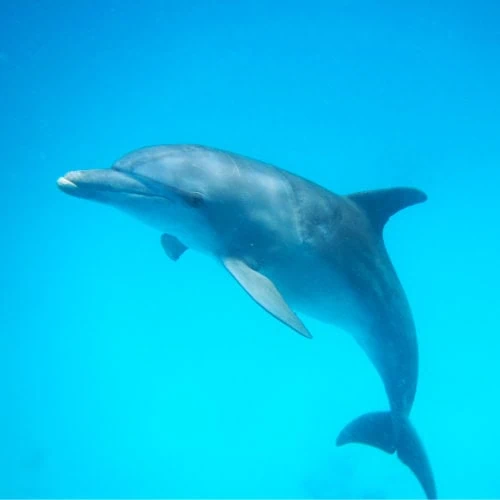
The bottlenose calves normally stay with their mother until the age of 1.5 – 2 years, but can stay for as long as 5 years. They have a life span of more than 40 years.
These Dolphins travel up to 100 km a day in search for food.
There are two ponds who live between Nungwi and Mnemba Atoll and are very commonly spotted. In fact, we often get a chance to jump in to snorkel with these Dolphins.
Green Turtle
The Green turtle’s name comes from the color of their fat and not their shell, despite the common belief.
The green turtle is the second largest after the leatherback. They can weight up to 225 kg and reach 1.2 m in length. Green turtles are able to hold their breath for hours at a time.
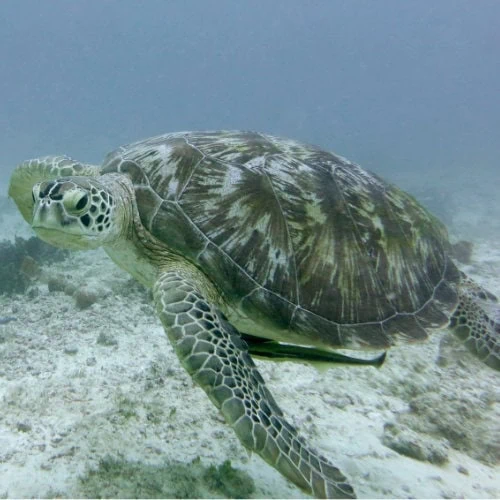
Green Turtles are very common in Zanzibar. They are used to seeing divers and will not run away if you happen to get closer of a better shot.
Seahorse
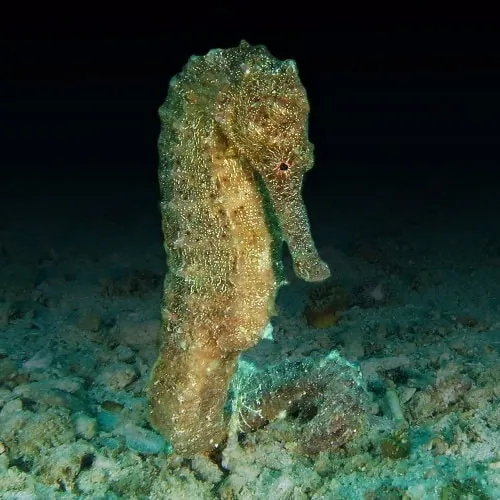
Seahorses might not look like a typical fish, but they are classified as a fish.
Seahorses mate for life. In fact, they are among the only animal species on Earth in which the male carries the unborn young.
Seahorses main predators are crabs.
There are a number of species of seahorse in Zanzibar, such as the Spiny Seahorse. Our guides know where to find them on Tumbatu Island and Magic Reef.
Mantis Shrimp
Mantis shrimp have the best color vision on our planet. Their eyes mounted on mobile stalks and constantly moving about, independently of each other.
The mantis shrimp has a striking punch that can reach the same speed as a .22-caliber bullet. It kills its prey with a deadly strike, so keep your fingers away!
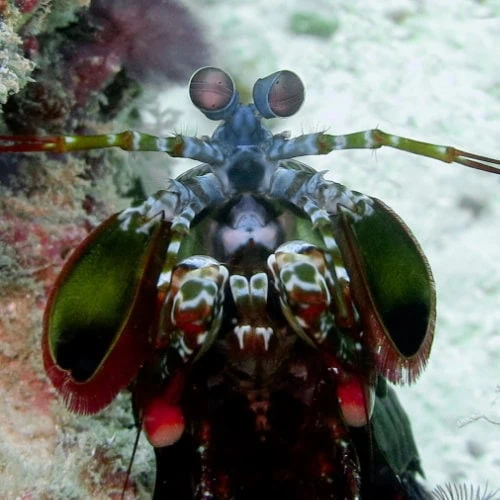
Mantis Shrimp is very common on Zanzibar on all dive sites.
Nudibranch
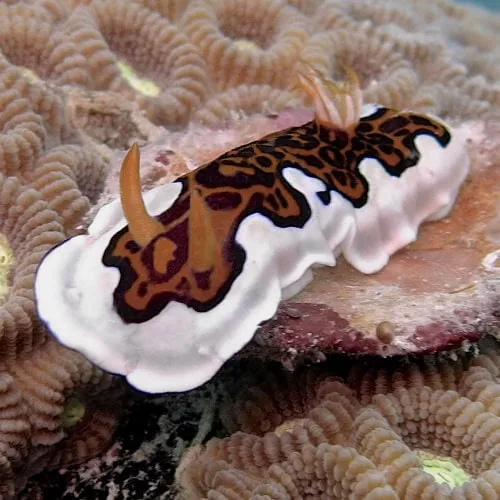
Nudibranchs are sea slugs. They have a foot and they leave a slimy trail. There are more than 3,000 species of colorful nudibranchs.
Nudibranchs get their bright colors from the food they eat such as sponges, anemones and corals. They have a poor vision though and can not see their own colors.
There are many types on Zanzibar, including the famous Spanish Dancer, which if you’re lucky you can find dancing (swimming) during one of our night dives.
Octopus
Octopus is one of the most intelligent of all invertebrates. As a master of camouflage, an octopus can change the color of its entire body in just three-tenths of a second.
Octopus can observe, learn and even solve problems. They have been seen removing a plug or unscrewing a lid in order to retrieve prey from a container.
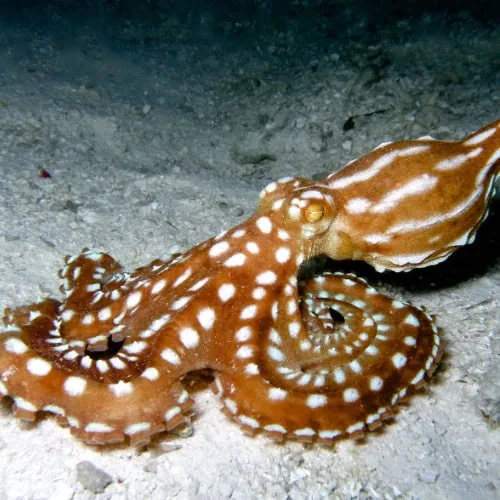
Octopus are common on all our dive sites, especially on night dives as they are out hunting.
Humpback Whale
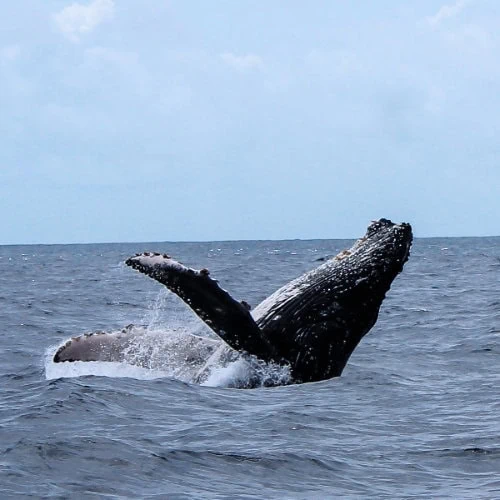
Humpbacks are acrobatic and can breech their 40 tons completely out of the water.
Humpbacks are known to sing. Their songs are complex, while each population singing its own unique song. Their songs are not inborn, they learn them from each other.
Humpbacks migrate through Zanzibar in August-September. Thus, they can be seen from the boat occasionally in these months, mainly in Mnemba and Leven Bank.
Harlequin Shrimp
Harlequin Shrimps spend their whole life with the same partner. Together they hunt and defend their homes.
They eat only starfish. They use their sense of smell for hunting. When they find a starfish, they work together to overturn it and disable it, often carrying it back to their hiding place, where they can spend days feeding from it.
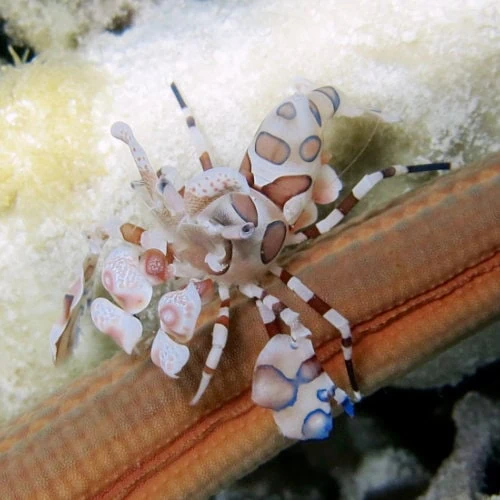
Although rare, you can see harlequin shrimps on the Nungwi Reef as well as Magic Reef. Though, you are more likely to see them at night.
Frogfish
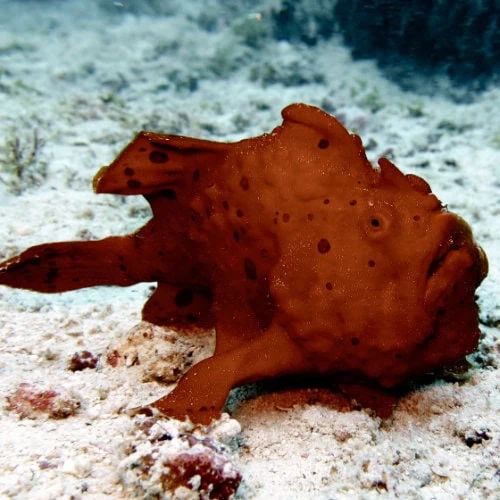
Frogfish don’t usually swim, they use their fins to walk.
A Frogfish’s mouth can expand to 12 times its regular size. Therefore, it can swallow an animal twice its own size!! And since a Frogfish does not have teeth, it will swallow it in one piece!!
You can find them on almost any dive site, as long as you’re sharp enough to spot them.
Moray Eel
Morays hunt a night. They have poor vision, so they mostly rely on their keen sense of smell to hunt.
To breathe, moray eels must continually open and close their mouths to move water over their gills. Scuba divers often incorrectly interpret this behavior as threatening.
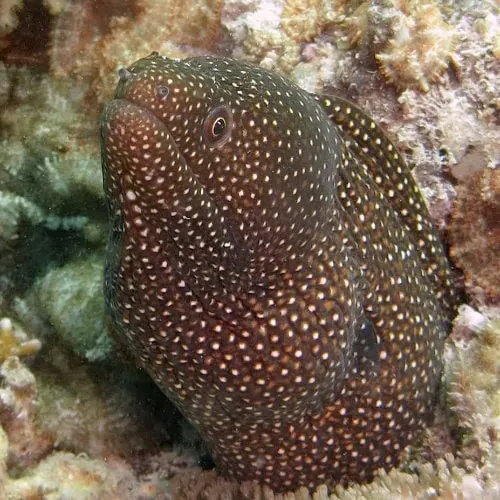
There are many kinds of moray eel in Zanzibar such as Peppered Morays, Giant Morays, Honeycomb Morays, Ribbon Eels, Snake Eels.
Cuttlefish
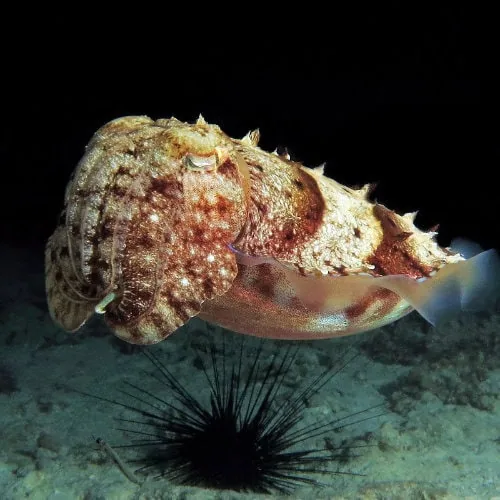
Cuttlefish are known as the “chameleon of the sea” and rightly so. They have the extraordinary ability to change color to match their surroundings. The cuttlefish use this amazing talent to hide, hunt, communicate and even to attract a mate.
They are regarded as the most intelligent invertebrate.
You can find cuttlefish on all the dive sites, even during one of our offshore night dives.
White Tip Reef Shark
The White Tip Reef Shark is a very social fish. They often lay on the ground in large groups.
White tips can lie motionless on the bottom and actively pump water over its gills for respiration, unlike most other sharks who need to be in constant movement.
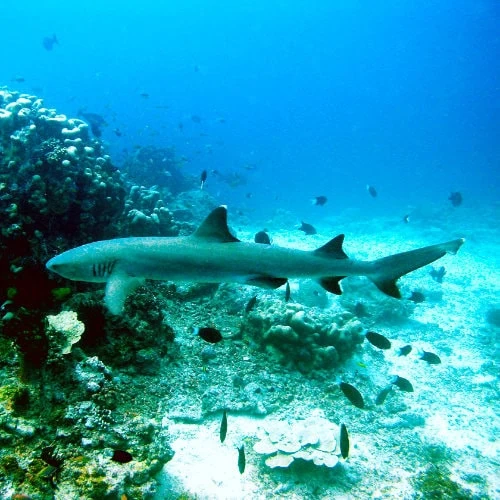
White Tips can be seen in Mnemba although in recent years they are not very common, and we might spot them only few times a month.
Trumpetfish
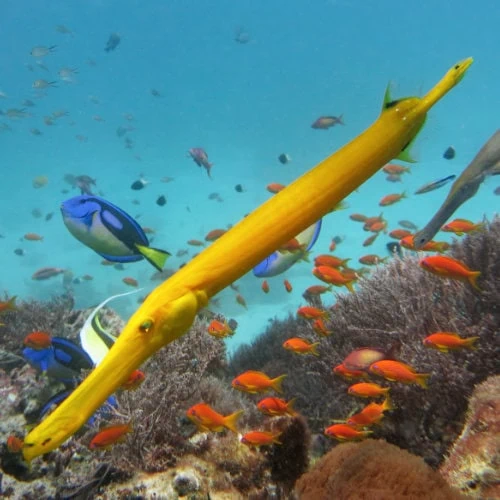
Trumpet fish are true killing machines. In fact, one of its most spectacular method of hunting is Shadow Stalking. The trumpetfish will find a large herbivore, such as a parrot fish, which is nonthreatening to the smaller prey, and will ride along the side of it using it as a blind. Then when the unsuspected prey gets close the trumpetfish darts out catching its dinner.
You can find trumpetfish on all our reefs, and you often see them displaying this behavior.
Porcelain (Anemone) Crab
The porcelain crab has 2 large claws which are simply used for defending their territory and not typically used for hunting lunch. If threatened, the porcelain crab can drop a claw. But don’t worry, it will grow back in no time.
The female crab is relatively small but is able to carry up to 1600 eggs at a time.
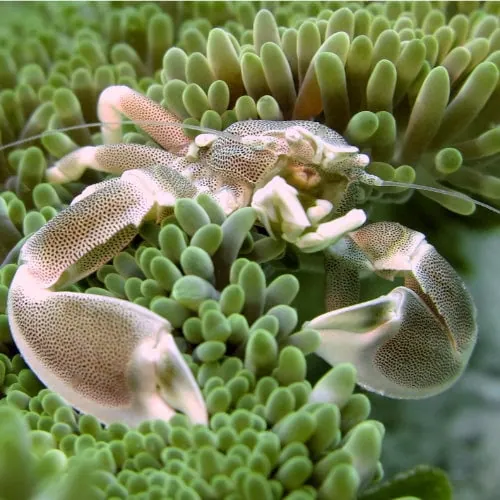
These crabs live on all dive sites. Just look carefully into all the anemones you come across, and you are sure to spot one.
Napoleon Wrasse
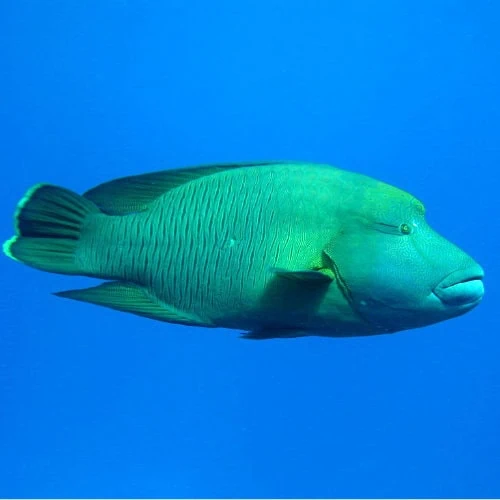
The Napoleon is one of the largest fish on the coral reef. In fact, it can measure up to 2.3m in size and weigh up to 190 kg.
This wrasse is a true eating machine! They feed on giant clams, eels, sea urchins, star fish, as well as other fish including smaller species of wrasse.
You can often spot these giants in Mnemba Atoll or Leven Bank.
Stonefish
The Stonefish is the most venomous fish found on the Coral Reef.
They are not aggressive and tend to use camouflage as a means of defense. It usually sits amongst Coral rubble or stones, with which it blends incredibly well. Sometimes they bury themselves in the sand with only the top of the head and the eyes exposed.
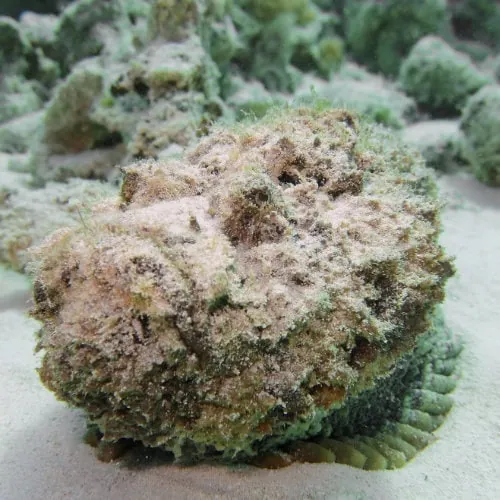
You can find Stonefish in almost all the reefs that we visit.
Lion Fish
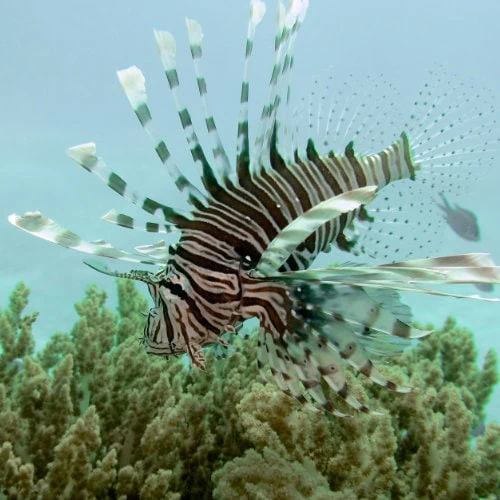
Lion Fish have between 13 and 18 venomous spines on the back side of their body. However, the venom is used only in self-defense.
They are either solitary or in a group containing one male and a few females. The male lion fish is highly territorial and will protect his territory pretty fiercely.
Lion fish are extremely common in Zanzibar. You will definitely see them on all dive sites.
Crocodile Fish
The Crocodile fish is a bottom-dwelling ambush hunter. It feeds largely on smaller fish.
It got it’s name due to it’s resemblance to the reptile.
The crocodile fish is easy to approach and is indifferent toward divers.
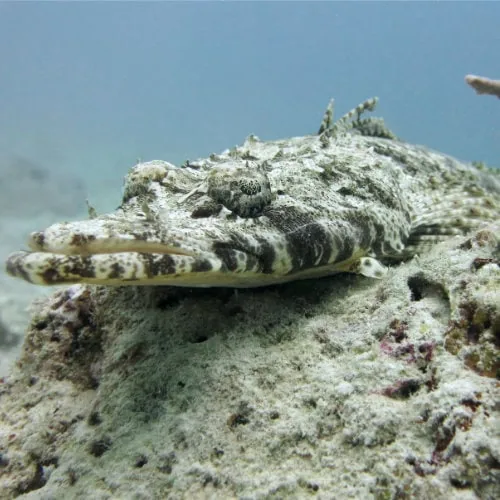
Crocodile fish are very common in Zanzibar, but you are most likely to see them in Hunga and Magic Reef.
Dive Sites of Northern Zanzibar.
Photo Gallery of Zanzibar marine life.
Diving in Zanzibar – Homepage.
Bluefin Trevally
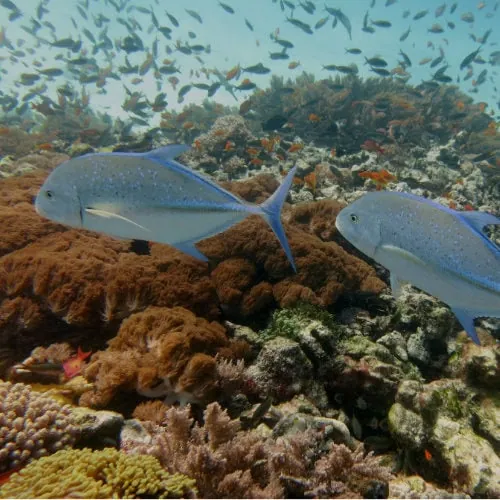
Bluefin Trevally are extremely strong swimmers and swim long distances in search of food.
They are fast, aggressive fish when it comes to hunting and have even been known to even take food from the mouth of feeding sharks.
While mostly solitary, they can also be found in small groups or pairs. You are very likely to see these fish hunting around the Mnemba Atoll.
Weedy/Mauritius Scorpionfish
The Weedy Scorpionfish use their camouflage to blend into their environment.
To move they use their pectoral and pelvic fins to drag themselves along the floor.
When hunting, they lay motionless for unsuspecting prey to pass within striking distance.
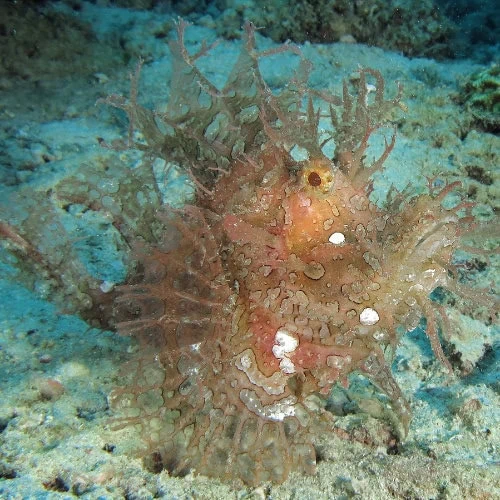
You may find them in Magic Reef, swaying on the floor like a piece of seaweed.
Ghost pipefish
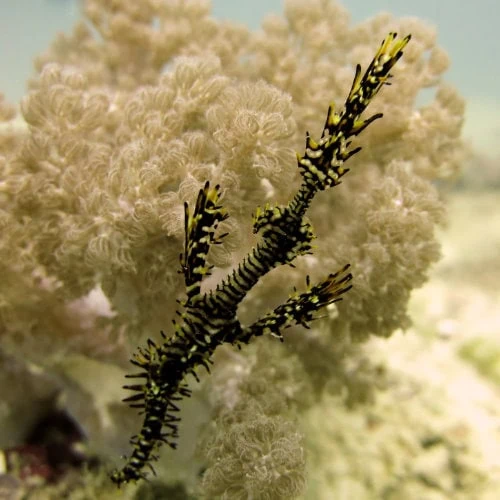
Ghost pipefish are masters of disguise. They can look like leaves, algae, sponges and even seagrass, making them very hard to spot.
Here in Zanzibar we are lucky enough to have a few different species, such as ornate ghost pipefish, Seagrass Pipefish and Slender Ghost pipefish.
Ghost pipefishes live on many of Nungwi’s reefs, and it is more common to find them in Magic Reef. They are not easy to see, so keep your eyes open.
Flying Gurnard
The flying gurnard cannot fly as the name might suggest, but when threatened they expand their fins/wings to scare off a predator, making it seem like they are gliding through the water.
The pelvic fins act as legs as the fish walks along the bottom of the ocean.
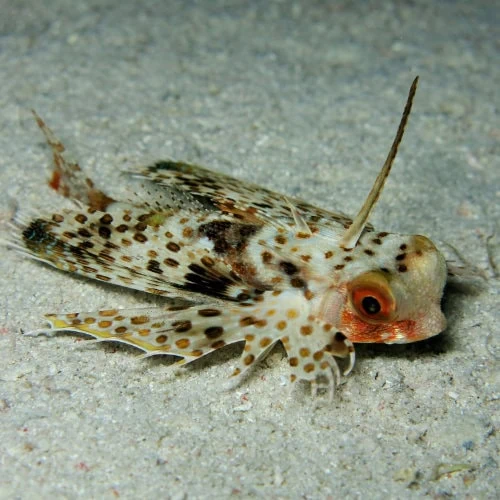
You can see this fish on almost every night dive and often during the day.
Indian Ocean Walkman
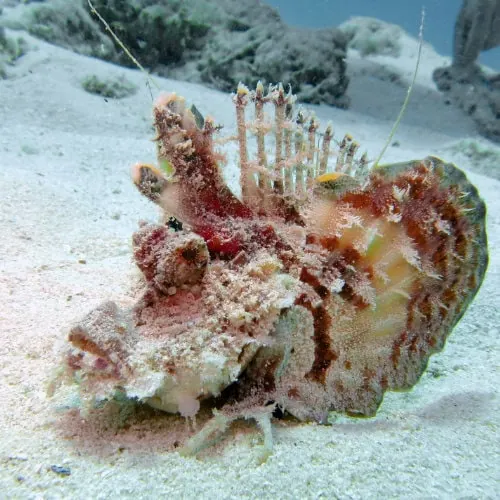
The Indian Ocean Walkman is closely related to the scorpionfish & the stonefish. It is usually well camouflaged, and you can often find it partially buried in the sand.
It is unable to swim efficiently and prefers to drag itself along the sand using 4 rays (legs) located on the pectoral fins.
You can find the Indian Ocean Walkman in Mnemba and Magic Reef.
Blue spotted Ray
Unlike other rays, the blue spotted ray rarely buries itself beneath the sand, and you are more likely to find it hidden under a rock.
It gets its name from the bright blue spots on its back. These spots are to warn predators to keep away.
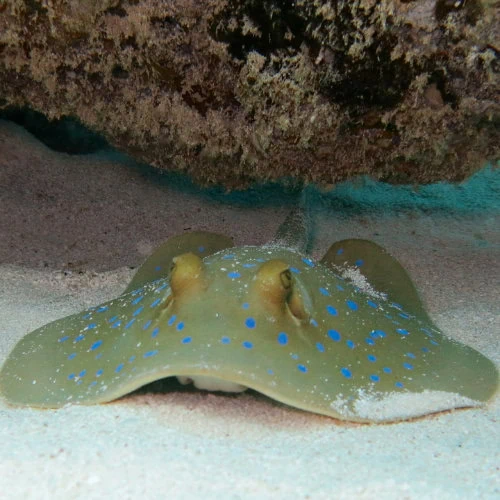
You can find these rays on every dive site in Zanzibar. Just look in all the gaps and under all the rocks.
Leaf Fish
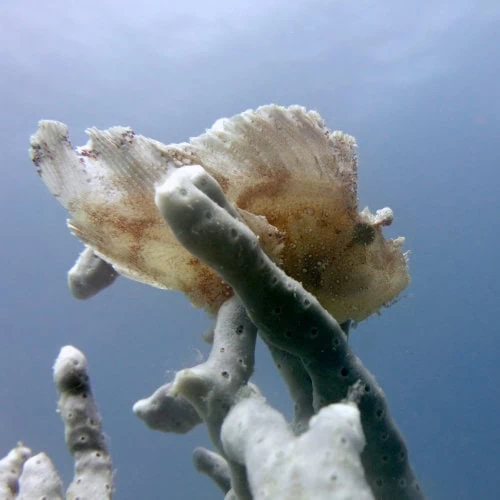
The leaf fish regularly occurs in pairs.
A leaf fish will rock from side-to-side or back and forth to mimic a piece of plant.
When feeding, it awaits an unsuspecting small fish or moves toward it slowly, taking it with a sudden gape of the huge mouth.
Leaf Fish are very common on Zanzibar.
Scorpionfish
The scorpionfish is a large group of bottom dwelling predatory fish. There are more than 200 recognised species. A number of them can be found in Zanzibar.
The scorpionfish is a nocturnal predator and spends the daylight hours blending in with the corals, rocks and sand.
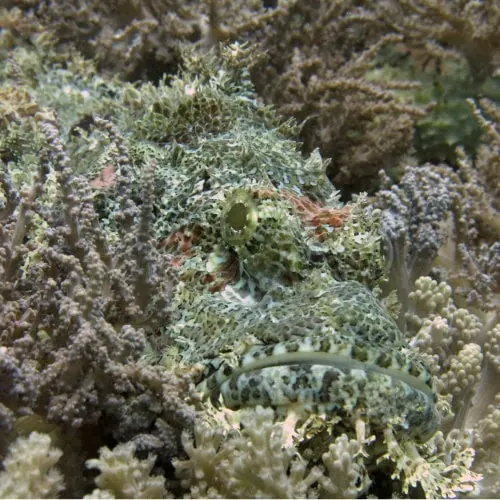
You can easily find scorpionfish on all our dive sites.
Pegasus Sea Moth
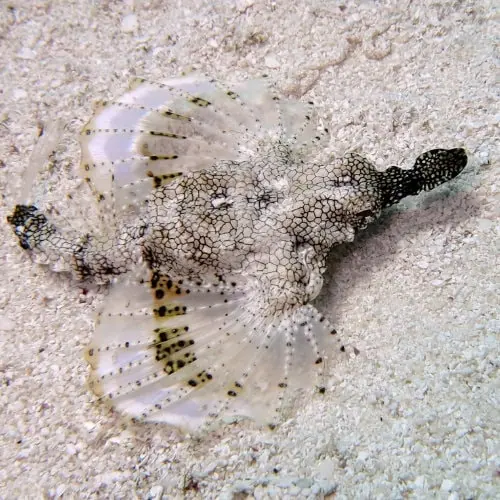
The Sea moth is a bottom dwelling creature and lives on sandy beds.
They feed on whatever they can find on the seabed. Their body armor provides protection from predators. Curiously, they shed this bony external armor in a single piece in an effort to rid themselves of offensive organisms.
If you have a keen eye, you can spot these special little creature in the Mnemba Atoll and Magic Reef on a sandy area.
